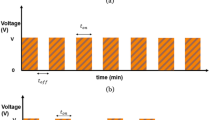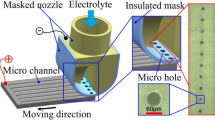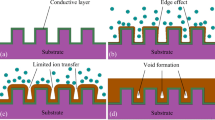Abstract
The objective of this study is to establish the limit of the metal forming process in terms of size and accuracy. In the present investigation, micro channel forming with ultra thin metallic foil by the sheet metal forming process was studied. In order to examine the fabrication limit of the process, both the channel size needed to be as small as possible and the sheet thickness to be as thin as possible. Copper foil 1.0 μm thick was made into 5.6 μm wide and 3.2 μm deep channels. The shapes of the channels were straight line, concentric circle, cross, and other curved shapes. Forming was done by cold isostatic pressing. Single crystal silicon wafer was used as the die material, and die grooves were made by micro machining techniques. The die, metallic foil, and plasticine as the pressure-transmitting medium were vacuum packed in a bag made of multilayered film. The forming was conducted with a cold hydrostatic press where the forming pressure was 240 MPa. The formed channels were examined in terms of their dimensions and surface qualities. Based on the examinations, channel formability was also discussed.
Similar content being viewed by others
References
Saotome Y, Miwa S, Zhang T, Inoue A (2001) The micro-formability of Zr-based amorphous alloys in the supercooled liquid state and their application to micro-dies. J Mater Process Technol 113:64–99
Saotome Y, Iwazhki H (2001) Superplastic backward microextrusion of microparts for micro-electro-mechanical systems. J Mater Process Technol 119:307–311
Plancak M (1998) Coining process as a means of controlling surface micro geometry. J Mater Process Technol 80–81:101–107
Boehm J, Schubert A, Otto T, Burkhardt T (2001) Micro-metalforming with silicon dies. Microsyst Technol 7:191–195
Wakabayashi K, Onishi A, Masuzawa T (1990) Micropiercing on stainless steel. Bull Jpn Soc Precis Eng 24(4):277–278
Mori T, Hirota K, Tokumoto D (2000) Improvement of ultra-fine piercing by vacuum system. Proceedings of the international symposium on micromechatronics and human science, Nagoya, Japan, pp 77–82
Joo BY, Oh SI, Jeon BH (2001) Development of micro punching system. CIRP Ann 50(1):191–194
Saotome Y, Okamoto T (2001) An in-situ incremental microforming system for three-dimensional shell structures of foil materials. J Mater Process Technol 113:636–640
Liu Y, Liew LA, Luo R, An L (2001) Fabrication of SiCN MEMS structures using microforged molds. Proceedings of the 2001 IEEE international conference on microelectromechanical systems (MEMS 2001), Interlaken, Switzerland, 21-25 January, pp 119–121
Joo BY, Oh SI, Son YK (2004) Forming of micro channels with ultra thin metal foils. CIRP Ann 53(1):243–246
Madou M (1997) Fundamental of microfabrication. CRC Press, Boca Raton
Kurosaki Y (1993) Thickness dependence of equi-biaxial yield stress and limit strain in electronic copper sheets and foils. Adv Technol Plasticity 3:1893–1898
Author information
Authors and Affiliations
Corresponding author
Rights and permissions
About this article
Cite this article
Joo, B.Y., Son, Y.K. & Oh, SI. Micro channel forming with ultra thin metallic foil by cold isostatic pressing. Int J Adv Manuf Technol 32, 265–271 (2007). https://doi.org/10.1007/s00170-005-0321-5
Received:
Accepted:
Published:
Issue Date:
DOI: https://doi.org/10.1007/s00170-005-0321-5




